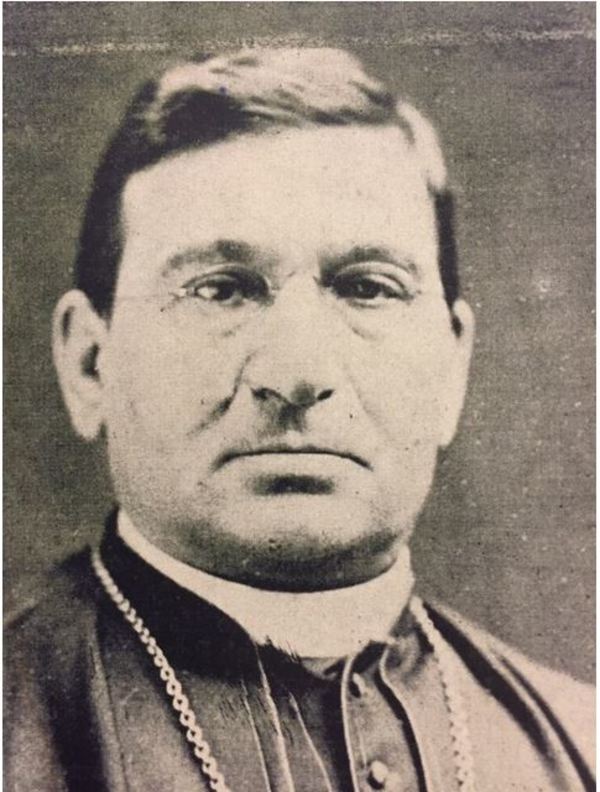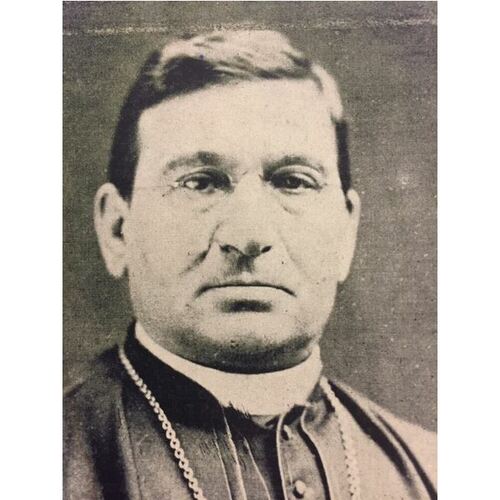
Source: Link
CARFAGNINI, ENRICO, Franciscan, Roman Catholic, priest, educator, and bishop; b. 23 March 1823 in Aversa (Italy), son of Liborio Carfagnini and Ascenza Ciancarelli; d. there 2 Dec. 1904.
Enrico Carfagnini entered the convent of St Martin in the town of Magliano de Marsi in 1838 and took his vows as a Franciscan friar minor on 21 July the following year. After studying theology at convents in Raiano and Scanno, he was ordained priest on 19 Nov. 1846. Carfagnini lectured on theology and philosophy in Raiano, Rome, and Penne and from 1854 at the Irish Franciscan college of St Isidore’s in Rome. There he met Bishop John Thomas Mullock* of Newfoundland, who invited him to become president of St Bonaventure’s College, the seminary planned at St John’s. He arrived there in 1856.
Besides serving as college administrator, Carfagnini taught philosophy and theology, yet he remained a somewhat distant figure to his students. From documents submitted to Rome by the Harbour Grace clergy in the 1870s, it appears that friction with Mullock resulted in Carfagnini’s dismissal and suspension as priest. Although the specifics of the dispute remain unclear, it may have concerned the opening of St Bonaventure’s to Protestants in 1863. Throughout his stay in Newfoundland Carfagnini opposed “mixed” institutions. He also objected to the education of St Bonaventure’s alumni at St Isidore’s rather than at the Urban College of the Sacred Congregation of Propaganda.
In 1864 Carfagnini supervised the building of the cathedral in Harbour Grace for Bishop John Dalton*. When Dalton died five years later, Carfagnini was chosen to succeed him, and he was consecrated on 22 May 1870 in Rome. The election came as a surprise to the clergy and people of Harbour Grace, who had not been consulted on the matter. Carfagnini had been supported only by a letter from Bernard Duffy, a long-time missionary, who recommended him especially for his activities at St Bonaventure’s College and as builder of the cathedral in Harbour Grace. Never a regular missionary priest in the diocese, Carfagnini had returned to Italy upon Dalton’s death after an acrimonious financial dispute. John Walsh, the diocesan administrator, complained to Rome of his “total disrespect of authority” and his insufficient command of spoken English.
His episcopate was a period of constant strife and tension for the clergy and parishioners of the diocese. One area of conflict concerned the Benevolent Irish Society, established at Harbour Grace in 1814, which had already experienced Carfagnini’s scorn during his tenure there as priest. This voluntary association, officially non-denominational but almost exclusively Catholic, had collected and distributed thousands of pounds to the poor and needy of Conception Bay. Its civil character kept it outside the bishop’s sphere of authority, while its benevolent activities endowed it with considerable power. For Carfagnini such an organization was tantamount to an anti-Catholic or secret society. The bishop, influenced by a strictly autocratic Latin model of church government rather than the participatory tradition of immigrant Irish Catholics, was opposed to sharing power and prestige with lay organizations and especially resented the presence of the BIS at public processions and the funerals of society members. BIS supporters repeatedly affirmed their religious loyalty. They pointed out that lay-administered voluntary associations formed along professional, ethnic, and religious lines were a feature of North American society and did not pose a threat to the Catholic Church. Rather, the BIS represented a positive force in the community by linking religion and nationality.
The struggle culminated in a solemn anathema of the society, pronounced by the bishop on Passion Sunday 1874 in the Harbour Grace cathedral, which deprived members of the sacraments and a Christian burial. Priests supportive of the BIS were suspended, and a second, denominationally exclusive, benevolent association was formed, loyal to the bishop and his few clerical supporters, albeit with divisive consequences in the community. During the dispute, the bishop and his cathedral priest, Diomede Falconio, had also sought to rally popular support through the Total Abstinence and Benefit Society, a more pliable and entirely Catholic lay organization founded by Carfagnini in 1868 and now under Falconio’s direction. The Harbour Grace conflict was not unlike that experienced earlier in the century by Bishop Michael Anthony Fleming*, who gained control of the nondenominational orphanage school operated by the Benevolent Irish Society of St John’s only after a prolonged struggle. Carfagnini was not so fortunate; he lost when in 1875 Rome decided that the BIS was indeed a civil organization and thus outside the bishop’s jurisdiction.
Another source of contention was the presence in Conception Bay of the Presentation sisters [see Miss Kirwan*, named Sister Mary Bernard]. The Irish-based congregation had been introduced to Harbour Grace in 1851 by Bishop Mullock in an effort to solidify Catholicism by creating what Bishop Fleming had once called a “race of [Catholic] mothers.” The sisters taught the girls of the community and began adult instruction on Sundays. By the time Carfagnini arrived, they were solidly entrenched in Conception Bay society. Their financial independence had been assured when missionary Charles Dalton* bequeathed them a house and a 23-acre farm. To the bishop the role of the sisters in the diocese represented one more example of Irish Catholic independence from episcopal control. His imposition of Father Falconio as confessor to the Harbour Grace convent only heightened existing tensions. Carfagnini made several unsuccessful attempts to remove the sisters from Conception Bay and thus weaken the Irish element in his diocese. Their superior, Sister Mary Xavierus Lynch, sought protection for her convent through her brother James Lynch, coadjutor bishop of Kildare in Ireland.
Carfagnini also failed to gain control over his predecessor’s estate, which was administered by his adversary John Walsh. He attempted to improve his financial situation by collecting on the French Shore dues that had previously flowed into the coffers of Tilting Harbour and by separating the resource-rich region of Fortune Harbour from the same parish, to the detriment of the long-time parish priest, James Brown.
The severity of Carfagnini’s authoritarian measures can partly be explained by his isolation from the Irish and local clergy. His support was largely confined to fellow Italian Falconio, William Veitch, a priest with little theological training, and the Reverend E. F. Walsh, nephew of his sponsor, Bernard Duffy. The resignation and suspensions of priests who had remained loyal to the BIS further strained relations in the community and established an increasingly effective lobby against him in Rome. This opposition also included the BIS in St John’s; Bishop Thomas Joseph Power*, who resented Rome’s reassignment of two St John’s parishes to Harbour Grace, and almost his entire clergy; Paul Cardinal Cullen of Dublin and other Irish bishops who were related to priests or nuns affected by Carfagnini’s actions; and even members of St Isidore’s College.
In 1875 public statements by Falconio and Power revealed that Carfagnini had been instructed by Rome to revoke his censure of the BIS and remain in Newfoundland for only two more years. Had it not been for a face-saving measure by the Sacred Congregation of Propaganda, he might indeed have departed in 1877 and spared the diocese much additional conflict. Repeated attempts by such outsiders as Power, Bishop John Cameron of Arichat, N.S., and George Conroy*, the apostolic delegate to Canada, to mediate the disputes were unsuccessful. By 1879 new strife with the BIS, the Presentation sisters, and the clergy made Carfagnini’s position untenable, and on 4 April Propaganda demanded that he resign. He did so the following month.
On 27 Feb. 1880 Carfagnini became bishop of Gallipoli in Italy, from where he still sought to influence matters in Harbour Grace through Propaganda and Diomede Falconio, now administrator of the diocese. He retired from his Italian see with archiepiscopal honours in 1898 and subsequently resided in Sulmona and Rome. Carfagnini died six years later at his home town of Aversa while on a visit to his nephew.
There are numerous documents pertaining to Enrico Carfagnini strewn through several collections in the Arch. of the Archdiocese of St John’s: James Brown, letters to Rome, 1878–79, and to Carfagnini, 17 Sept. 1879; Carfagnini papers, including receipt for John Walsh, administrator of Dalton estate, 20 Dec. 1870, Latin instructions to clergy of Harbour Grace, 1 Jan. 1871, Carfagnini to Walsh, 13 July 1871, Carfagnini to Brown, 14 Aug. 1879, Decretal regarding Tilton [Tilting] Harbour, 16 Aug. 1879, and pastoral letter as bishop of Gallipoli, feast of saints Peter and Paul, 1880; Clippings and articles regarding Carfagnini; Mullock papers, esp. Mullock to Connolly, 27 May 1856, Mackinnon to Mullock, 21 May 1858, and Mullock diary, 1857–58; Power papers, esp. diary, 8 April 1878; Protest of the clergy of Harbour Grace to Rome, 18 May 1876; John Walsh, letter to Rome, 28 Dec. 1876, and transcript of an extract from a sermon by Diomede Falconio, 4 Aug. 1878.
There are also several files of relevance to Carfagnini’s episcopate in the Arch. of the Diocese of Grand Falls, Nfld: Benevolent Irish Soc., 1873–76; BIS docs., 1876; Boundaries – Tilton parish and Fortune Harbour; Carfagnini information file, 1870–80, and pastoral letter, 1879; Corr. from Quebec to the bishop of Harbour Grace and to John Walsh; Corr. (personal); and Estates and wills.
Archivio della Propaganda Fide (Rome), Acta, vols.236, 238, 240–41, 243, 249; Lettere a decreti della Sacra Congregazione a biglietti di Monsignore Segretario, vols.361, 363–67, 369–76; Scritture originali riferite nelle Congregazioni generali, vols.997, 999, 1001–2, 1013; Scritture riferite nei Congressi, America settentrionale, vols.7–9, 11–12, 14–15, 17–21, 23; Udienze di Nostro Signore, 177: ff.228–29. Archivio Segreto Vaticano (Rome), Processus Consistoriales, 281 (1880): ff.260–65; Processus Datariæ, 242 (1880): ff.255–70; Segreteria dei Brevi, 5494 (1870): ff.3–9; 6120 (1880): ff.43–47; 6128 (1897): ff.164–68; Segreteria di Stato, 1897, rubrica 165, fasc.3: f.116. Benevolent Irish Soc. (St John’s), Minutes, 1857–75 (mfm. at PANL).
Adelphian ([St John’s]), 4 (1907): 5–8, 12 et seq. Canadian R. C. bishops, 1658–1979, comp. André Chapeau et al. (Ottawa, 1980). Centenary of the diocese of Harbor Grace, [1856]–1956, [comp. R. J. Connolly] ([St John’s, 1956]). Centenary volume, Benevolent Irish Society of St. John’s, Newfoundland, 1806–1906 (Cork, [Republic of Ire., 1906?]), 133–34. DNLB (Cuff et al.). Encyclopedia of Nfld (Smallwood et al.). Diomede Falconio, I Minori Riformati negli Abruzzi (3v., Rome, 1913–14), 1: 213–27; 2: 81–82, 93, 97, 105, 107, 111; 3: 424–36. La Gerarchia cattolica (Rome), 1904: 243. Hierarchia catholica medii et recentioris œvi . . . , ed. Conrad Eubel et al. (8v. to date, Regensburg, Germany, and Padua, Italy, 1898– ), 8: 204, 281, 465. A history of the Roman Catholic Church in Harbour Grace, comp. R. J. Connolly (St John’s, 1986), 42–71. Paul Cullen and his contemporaries: with their letters from 1820–1902, ed. Peadar MacSuibhne (5v., Naas, Republic of Ire., 1961–77), 5: 100. St John’s Total Abstinence and Benefit Soc., Jubilee volume, 1858–1908 ([St John’s, 1908]), 74–75. N. A. Veitch, “The contribution of the Benevolent Irish Society to education in Newfoundland from 1823 to 1875” (m.ed. thesis, St Francis Xavier Univ., Antigonish, N.S., 1965).
Cite This Article
Hans Rollmann and Matteo Sanfilippo, “CARFAGNINI, ENRICO,” in Dictionary of Canadian Biography, vol. 13, University of Toronto/Université Laval, 2003–, accessed April 25, 2025, https://www.biographi.ca/en/bio/carfagnini_enrico_13E.html.
The citation above shows the format for footnotes and endnotes according to the Chicago manual of style (16th edition). Information to be used in other citation formats:
| Permalink: | https://www.biographi.ca/en/bio/carfagnini_enrico_13E.html |
| Author of Article: | Hans Rollmann and Matteo Sanfilippo |
| Title of Article: | CARFAGNINI, ENRICO |
| Publication Name: | Dictionary of Canadian Biography, vol. 13 |
| Publisher: | University of Toronto/Université Laval |
| Year of revision: | 1994 |
| Access Date: | April 25, 2025 |



